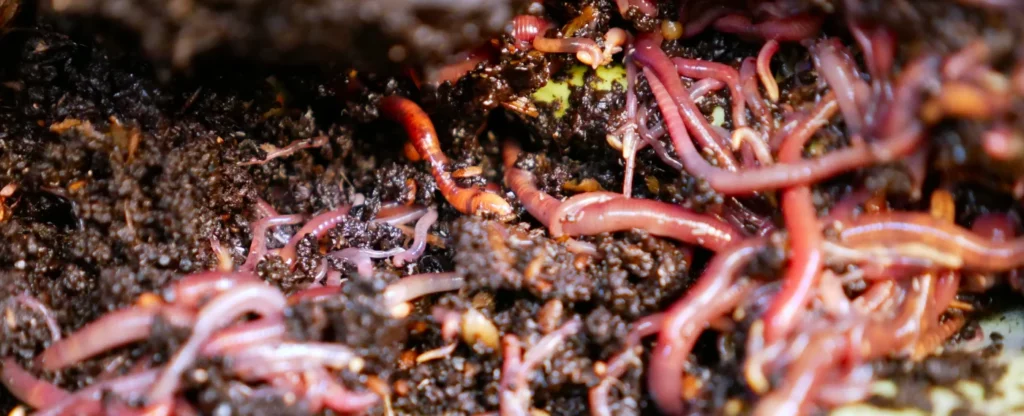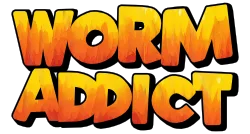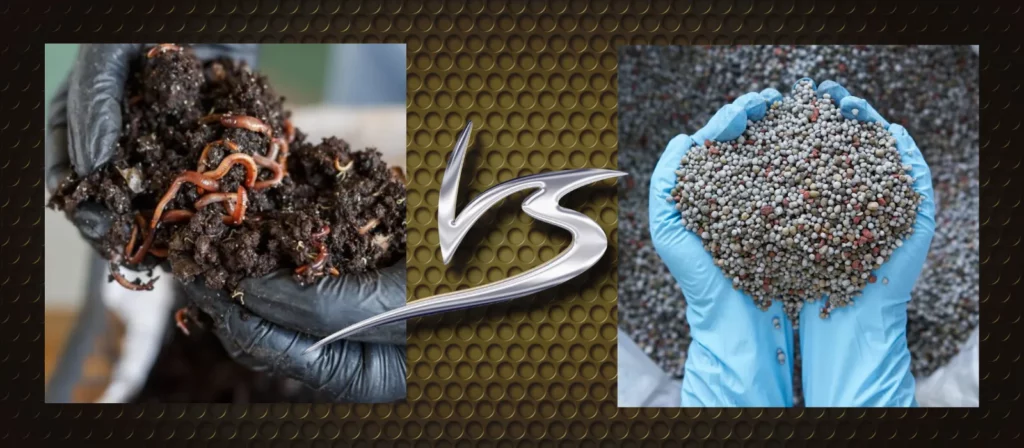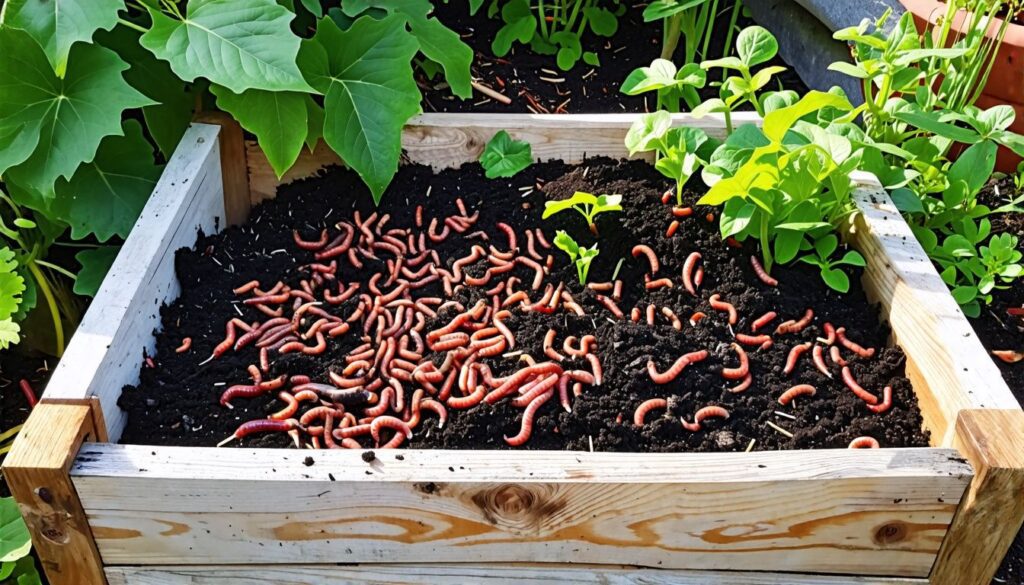Navigating the quest for a more eco-friendly lifestyle can often feel overwhelming. But, in our journey, we stumbled upon a small yet transformative ally: red wigglers, officially known as Eisenia fetida.
This article reveals how these tiny warriors can revolutionize your gardening practices, offering insights into composting, boosting soil health, and significantly reducing waste. Let’s dive into the remarkable world of red wigglers and uncover their potential together!
The Power of Red Wigglers for Sustainable Living

Red Wigglers transform kitchen scraps and yard waste into rich compost. They help us build healthier soil while reducing trash heading to landfills.
Soil Enrichment
Red wigglers, or Eisenia fetida, are remarkable allies for enriching soil. They thrive in the top few inches of soil, where they break down organic material efficiently. This process transforms waste into nutrient-rich compost that significantly enhances soil fertility.
By feeding on a diet of dead plants, live plants, and even animal waste, these worms improve the quality of our garden critters’ homes.
Their activity helps augment soil structure and boosts nutrient accessibility to plants. This makes red wigglers essential for sustainable agriculture and organic farming practices.
They are crucial for maintaining environmental sustainability by recycling organic waste effectively.
Soil health is vital for sustainable gardening; red wigglers make it possible.
Waste Reduction
Red wigglers significantly contribute to waste reduction. These industrious little worms excel at breaking down organic material, including dead plants, live plants, and even animal waste.
By composting with red wigglers in our homes or gardens, we can divert a substantial amount of kitchen scraps and yard waste from landfills. In doing so, we minimize the environmental impact associated with traditional waste disposal methods.
Their ability to convert this organic matter into nutrient-rich soil makes them essential for sustainable living. Not only do they process food scraps efficiently, but they also enhance soil quality as they enrich it through their natural activities.
Employing vermicomposting allows us to reduce our carbon footprint while supporting eco-friendly practices in gardening and farming. This simple yet effective method exemplifies how red wigglers serve as unsung heroes in promoting environmental conservation and sustainability.
Natural Fertilizer
Red wigglers act as powerful natural fertilizers. They break down organic materials quickly and transform them into nutrient-rich compost. This compost enhances soil fertility, making it vital for growing healthy plants.
In our own gardens, we’ve seen firsthand how the addition of worm castings boosts plant growth and vitality. These industrious invertebrates contribute to ecofriendly practices by recycling waste and reducing the need for chemical fertilizers.
As we recognize their role in sustainable living, it’s clear that incorporating red wigglers can lead to better gardening outcomes. We gain not only enriched soil but also healthier ecosystems all around us.
Understanding how to integrate these little creatures into our gardening efforts allows us to take a significant step toward more sustainable practices in everyday life.
Carbon Footprint Reduction
Red wigglers serve as powerful allies in carbon footprint reduction. These remarkable earthworms break down organic material, including dead plants and animal waste, transforming it into nutrient-rich compost.
This process significantly lowers the amount of waste that ends up in landfills, where it would otherwise produce harmful greenhouse gases.
By incorporating red wigglers into our composting efforts, we enhance soil quality while promoting sustainable food production methods. Their ability to create fertile soil makes gardening easier and more eco-friendly.
Together, we can reduce our reliance on chemical fertilizers and minimize our overall environmental impact through natural means.
Biodiversity
Biodiversity thrives in environments enriched by red wigglers. These worms play a critical role in promoting healthy ecosystems. By breaking down organic material like dead plants and animal waste, they enhance soil quality and increase nutrient accessibility for plants.
Healthy soil supports various organisms, leading to greater biodiversity in the garden and surrounding areas.
We can improve our gardening practices through these little champions of sustainability. Their contributions help create vibrant habitats that support wildlife while enriching our own gardens with nutrient-rich soil.
Moving forward, we can explore ways to incorporate red wigglers into our everyday gardening routines effectively.
How to Incorporate Red Wigglers in Everyday Gardening
Red wigglers thrive in our gardens, helping us create nutrient-rich soil. These remarkable worms can transform organic waste into valuable compost.
- Create a Worm Bin: We can set up a designated worm bin for red wigglers. This bin should be dark and moist to provide an ideal environment. Adding shredded newspaper and vegetable scraps will give them food and bedding.
- Add Kitchen Scraps: Tossing in kitchen scraps like fruit peels, coffee grounds, and leftover vegetables gives red wigglers plenty of food. They love organic matter and can break it down quickly, enriching our compost.
- Layering Technique: Alternate layers of brown materials such as dried leaves with green materials like grass clippings. This approach helps maintain moisture levels and provides diverse food sources for the worms.
- Monitor Moisture Levels: We must keep the worm bin moist but not soggy. Checking regularly ensures the conditions remain favorable for red wigglers to thrive while preventing any unpleasant odors.
- Use Compost Tea: After harvesting the compost, we can make compost tea by soaking it in water for a few days. This tea delivers nutrients directly to plants and enhances soil quality far beyond standard fertilizers.
- Introduce Them to Our Garden Beds: Red wigglers naturally inhabit the top few inches of soil in our garden beds. We can gently mix them into our garden’s soil to boost fertility and nutrient accessibility for plants.
- Maintain Regular Feeding: Consistent feeding keeps red wigglers strong and productive. A routine helps establish their growth patterns while ensuring they always have fresh material available.
- Observe Their Impact: Noticing changes in soil structure over time confirms their positive impact on our gardening efforts. Healthy soil leads to more vibrant plants and better yields from our sustainable practices.
- Utilize Their Castings: Collecting worm castings provides us with an excellent natural fertilizer that is rich in nutrients vital for plant growth, reducing dependence on synthetic options that harm the environment.
- Engage Family or Friends: Inviting family or friends into this process fosters awareness about sustainability practices among others while sharing the joy of working with these unsung heroes in gardening.
The Unsung Heroes of Sustainable Living
Red wigglers, scientifically known as Eisenia fetida, play a crucial role in creating nutrient-rich soil. These remarkable creatures excel at breaking down organic material, such as dead plants and animal waste.
Their tireless work enriches the soil and fosters healthy plant growth. We find ourselves benefiting from their natural composting abilities, which help return essential nutrients to the ecosystem.
This process enhances soil structure and amplifies fertility, making red wigglers vital for sustainable food production methods.
Our awareness of these industrious worms reveals their importance beyond typical garden critters. They contribute significantly to waste reduction by recycling organic materials that would otherwise end up in landfills.
Thriving in the top few inches of soil, they create an environment conducive to moisture retention and biodiversity. Red wigglers live symbiotically with their surroundings while supporting carbon footprint reduction efforts through efficient waste processing.
As unsung heroes of sustainable living, these little creatures remind us how nature’s renewable resources can help maintain soil quality and enhance sustainability in our gardens and communities alike.
Conclusion
We’ve seen the incredible impact that red wigglers can have on promoting sustainable living. From enriching our soil to reducing waste, these tiny creatures play a huge role in maintaining the health of our planet.
To gain deeper insight into their significance, we consulted Dr. Emily Henderson, a leading expert in sustainable agriculture with over two decades of experience. Holding a PhD in Environmental Science from Cornell University, Dr.
Henderson has significantly contributed to research on organic waste management and soil fertility enhancement methods.
Dr. Henderson points out how red wigglers efficiently convert organic waste into nutrient-rich castings, vital for improving soil quality and plant growth without chemical fertilizers.
She emphasizes the scientific principle behind vermiculture: as these worms process waste materials, they not only reduce landfill use but also secrete substances beneficial for plant roots and soil structure.
Addressing safety and ethics, Dr. Henderson asserts that using red wigglers is an environmentally friendly practice free from harmful chemicals found in synthetic fertilizers. She champions transparency in educating gardeners about their benefits while acknowledging certification processes for organic farming practices that incorporate vermiculture.
For integrating red wigglers into daily life, she recommends starting with small worm bins at home to dispose of kitchen scraps efficiently. This not only reduces household waste but also provides high-quality compost for gardens or indoor plants.
Balancing her evaluation, Dr. Henderson mentions possible challenges such as maintaining optimal conditions within worm bins to avoid odors or pests but reassures us that with proper management, these issues are minimal compared to the benefits of producing rich compost and enhancing biodiversity.
In her final verdict on the value of engaging with ‘Red Wigglers: The Unsung Heroes of Sustainable Living,’ Dr. Henderson strongly advocates for wider adoption among gardeners and households alike—highlighting its effectiveness as both a practical solution toward sustainability efforts and ecological responsibility.




